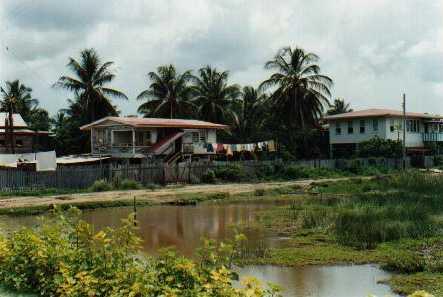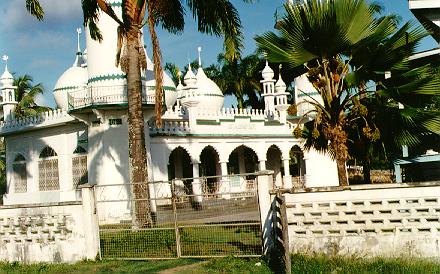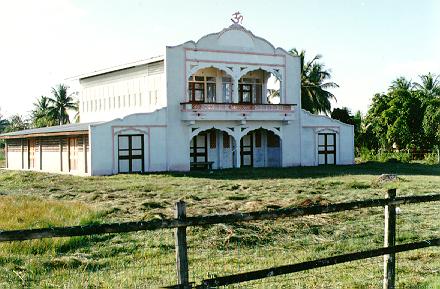Chapter 1
My Village
In 1990, I travelled to Guyana and spent a few days at Bush Lot, the village of my birth
and where I had spent my first twelve years. I walked through the once familiar side streets and
met old friends and relatives. After forty-two years, I still recalled some of their nicknames. It
was fun to talk about the “good old days” and to share tears and laughs--sad as well as
pleasant memories. Many of the customs and traditions are still there and these simple people
accepted me warmly and made my visit a happy and memorable one.
Bush Lot is located in the county of Berbice, fifty-six miles east of Georgetown, the
capital of Guyana. Twelve miles east is Rosignol which is connected by a two-mile ferry service
across the Berbice River to New Amsterdam, a small town. Close by is the Atlantic Ocean. On
moonlit nights we were able to see the reflection of light from the waves.
 |
| Map Of Guyana |
Most of Guyana’s population live on a northern strip of land which is less than two miles
wide. With an annual rainfall of 80 inches and the coastal area below sea level, flooding was a
constant threat to many villages. Since the livelihood of the people depended on flood control,
our village overseer had to ensure that the water, which resulted from heavy rains, was emptied
into the ocean at low tide. The salty ocean water was a threat to crops and kitchen gardens as
well as to the fresh water fish and shrimps in the many ponds. Hence “kokers”, flood control
locks, had to work properly.
All homes were built on stilts due to flooding. Most were built with wood, with roofs
covered by zinc sheets or wood shingles. The walls of others were plastered with mud and the
thatched roofs made from coconut branches or straw. The kitchen was usually separated from
the house because of the smoke from burning wood. The fireplace was made of bricks daubed
with a mixture of clay and cow dung. We had an oven attached to our fireplace. I remember
vividly my mother’s struggle to get the fire started with wet wood. There was smoke
everywhere. A “pookney”, an iron pipe through which air was blown, was used to start the fire.
 |
| Middle Dam |
Ninety-nine percent of Bush Lot’s population of 1500 were East Indians. They were
descendants of indentured immigrant labourers, who came from India 100-140 years earlier to
work at Bath, a sugar plantation. There were two Afro-Guyanese families and one Chinese
family, the Sue-Chungs. The residents of the surrounding villages, Golden Grove and Hope
Town, were predominantly Afro-Guyanese. In spite of the ethnic separation in these villages, I
was not aware of any problem during those early years.
Mr. Sue-Chung was an immigrant from China but his Chinese wife was born in Guyana.
Mr. Sue-Chung knew very little English. He was well liked and was known as Matty, Creole for
“mate”. Matty used to tell us stories which we did not understand. When he laughed we did the
same so as not to offend him. His son John and I were good friends and we played in each
other’s homes. Early one morning we were awakened by loud screams from the Sue-Chung’s
home. Mrs. Sue-Chung was hysterical. While preparing the day’s meals, her dress caught fire
and she was seriously burnt. In spite of Matty’s pleading, she refused to be taken to the
hospital or to visit Dr. Mook-Sang, our area doctor. To relieve the pain, she kept her right
forearm bent and the new skin in the upper and lower areas was fused together. Subsequently,
she was affected mentally and her relationship with her family seriously strained. Psychological
help was not available and her family neglected her. Matty took over the domestic chores for
his children John and Jem.
We spoke Patois, broken English, which was a combination of English, African and
Indian dialects. Georgetown residents felt that their speech was superior to that of rural
residents; they spoke a slightly different Creolese.
Bush Lot’s residents were chiefly rice farmers. Everything was done by hand. Their
farms were generally small and located some distance from the homes. To supplement their
income they planted coconuts and ground provisions--plantain, banana, cassava. In their
kitchen gardens they grew tomatoes, eschallots, boulanger (egg plant), bhagee (spinach), bora
(bean) and ochro. They also caught fish with a “cast net”, and shrimps with a hooped net,
called a “ghir-ghira”. Some residents kept a few chickens and ducks. While a few beggars
received rice and money, there were no homeless or starving people. The aged were taken
care of by their relatives.
The main road from Georgetown to Rosignol was made from burnt clay. Cars, buses
and lorries passed through and kicked up a lot of red dust creating a constant nuisance. Dust
was everywhere, even on one’s hair and clothing. During the rainy season, pot holes were
quite common. “Middle Dam”, extending from North to South, crossed the main road. When
rain fell, “Middle Dam” and the other side dams, all dirt roads, were a muddy slush. A railway
track, half a mile south of the main road, connected train services between Georgetown and
Rosignol.
Drinking water came from artesian wells. Six pipes served the whole village so in some
cases, water had to be transported over long distances. That chore was usually done by
children. Girls carried single buckets on their heads while boys carried two buckets on a lever
contraption called a “bahangi”, with a bamboo rod and a hook at each end for holding the
bucket. It was balanced on the shoulder which served as the fulcrum. The water was stored in
barrels. A few families collected rain water in large vats from the eaves troughs on roofs.
Bush Lot had two rice mills, four grocery stores, called salt goods shops, five cake
shops which sold bread, cakes, soft drinks, mauby drink, and ice, and two dry goods stores
which sold cloth. At that time no ready-made clothing was available so dress makers and
tailors were kept busy. A village market was held on Saturday mornings at the junction of the
main road and “Middle Dam”.
Along the main road were the Presbyterian and Pilgrim Holiness churches; the Hindu
and Muslim churches were on “Middle Dam”. My family belonged to the Presbyterian Church
and I attended Sunday school one hour before the regular Church Service in the school
building.
The Post Office, Police Station, and the Doctor’s office with residence were located at
Fort Wellington, two miles east of Bush Lot. The doctor, Dr. Mook-Sang, passed through the
village in his chauffeur-driven car twice a week. When medical help was needed a white flag,
attached to a wooden peg, was placed at the side of the road. Someone had to be nearby to
accompany the doctor to the patient’s home. Once I had a serious cut and needed stitches. I
had to be taken to the doctor’s home when he had completed his rounds through the
surrounding villages. I still have the marks of that cut on my left hand.
Since the village had no electricity, life came to a relative standstill in the evenings.
Every home had kerosene lamps or lanterns. The only residents who had kerosene-driven
refrigerators were the shopkeepers. With the exception of dried fish, perishable food was not
stored for any length of time. Milk had to be boiled several times a day to prevent spoilage.
Another food preservation method was “pepper pot” where meat, vegetables, casreep and hot
spices were cooked in a large pot. When other foods became available later in the day, they
were added to the boiling mixture and cooked. The “pepper pot” dish lasted several days. Ice
was sold once or twice per week on donkey drawn carts. It was too expensive to use ice for
refrigeration in a tropical climate. The few people who bought small quantities stored it in large
thermos flasks and used it in drinks. Ice was also sold as “shave ice” with a sweet red syrup on
top. This was always a treat for youngsters. Some people kept their water cool by using
goblets, porous clay pots which work by evaporative cooling.
Very little money circulated but there was cooperation and people helped each other.
Relatively no petty crime existed during that period. However, there was one major blemish in
Bush Lot’s record, a murder which took place when I was about eight. A villager was hanged in
Georgetown for the murder of his wife.
Bush Lot became active when three major sports events - horse racing, athletic sports
and cricket games took place. They were held on a sandy area north of the village. Two
individuals, Sewsankar Maraj and Joe Persaud (Uncle Joe), brought joy to children on sports
days. They handed out candy and pennies to us. Uncle Joe was one of the two residents who
had radios. When cricket games were being broadcast from Georgetown, he used to turn up
the volume for us to listen from outside his home.
Weddings were usually celebrated with pomp and ceremony. My sister Hilda’s wedding
was performed according to East Indian as well as English tradition. The food was cooked in
large pots on the night before the wedding. This was accompanied by entertainment--East
Indian music, dancing and singing. The marriage took place in the Bush Lot Presbyterian
Church and the festivities were held at our home. The whole village was invited as was the
custom in those days. With the passage of time such large weddings no longer take place.
When a villager died, an immediate relative passed through the village, rang a bell and
shouted the death announcement. The burial took place the following day because of lack of
refrigeration facilities. Today death announcements are made over the radio and refrigeration
facilities are available in New Amsterdam and in Georgetown.
The present population of Bush Lot has quintupled its 1940s figure. This growth has
brought prosperity as well as problems. Today, the village has many beautiful homes with
electricity, television, refrigerators and stoves. Children are neatly dressed in school uniforms
and have school bags and shoes. There are a few cars, lorries, tractors and combines. Gone,
however, is the close-knit society. Inflation has created a less caring community. Infra-
structure is sadly neglected. There is need for improvement in water supply, sanitation and
road maintenance. I also saw the need for a community centre, a park and a library. As my
contribution to Bush Lot, I helped to set up a Reading Centre in the Village Office in September,
1995. The books sent to the Reading Centre are purchased at garage sales, collected from
Library discards or are gifts from friends and relatives. I hope to continue to send books
annually. I also hope that my efforts will be an incentive to others to make similar contributions
to their community.
Addendum --- 2011
There has been great economic progress in Bush Lot during the last fifteen years.
The population has expanded from about 4 000 to over 10 000.
Several mud dams which had been a night mare after a rain shower have been widened and replaced
by brick and asphalt roads. Many new business establishments have been set up and residents from
surrounding villages are now doing most of their shopping in Bush Lot. There are now three
Chinese restaurants, two supermarkets, three snackettes, six jewellry establishments,
four inter-net cafes, a taxi service, a tractor and combines sales and repair business,
two lumber yards, three hardware stores, a photo shop,
a spray painting and body work shop and and a Truck Assembly Plant.
Significant progress has also been made in the Health field. In 1948 a Community Nurse and a
Health Care Centre were the only Health services present. Along with this, there is now a
Community Hospital at Fort Wellington. There are also three Medical doctors as well as Nurses and Pharmacies in the Village.
Bush Lot has always been a farming community with an emphasis on rice cultivation and the rearing of cattle.
Sea fishing and fresh water fishing were also popular but these were chiefly for consumption
within Bush Lot and the surrounding communities. There has been significant growth in cash crop farming
--- tomatoes, boulangers (egg plant), peppers and bora, and shallot.
The market for this produce is both within the local communities but also larger markets.
In spite of the economic progress there are several infrastructure needs. The most pressing is for
adequate garbage disposal. Several years ago Mr. Cheddie Sewsankar tried to establish a site but he
was unable to convince residents to take their garbage there. At present garbage is disposed
haphazardly throughout the village. The Village administration has to take on this urgent
problem and establish a central garbage disposal site.
I would also like to see a little park or children's playground with benches, a swing, a slide,
a see-saw and other fun things for children. An ideal location is the Nursery School.
This playground should be available to the public when school is not in session.
I had tried to establish a Library but this ended in failure after a few years. I am glad to hear that the
Bush Lot United Sports Club, Library and Research Centre has been established.
I do hope that this facility will be used by residents.

| Muslim Mosque |
|

| Hindu Temple |
|
ToC
Preface, Acknowledgements & Introduction
Chapter 2



